Georgia is a great place to look for mushrooms—it’s got a lot of land area, and most of it is subtropical (long growing season, gentle climate), but the mountains offer growing conditions more typical of landscapes hundreds of miles to the north. There is no way to discuss all of the mushroom species native Georgia, there are way too many. We can explore some of the more common and the more interesting ones, though.
Our Recommended Field Guides for Georgia
COVER | TITLE | Header | ||
|---|---|---|---|---|
OUR #1 RATED | ||||
Edible Wild Mushrooms in Georgia
It’s worth noting that the difference between edible and poisonous mushrooms can be a little fuzzy. Many well-known edibles sometimes make a few people sick, and most must be properly cooked to be safely eaten at all. Then there is the real danger of misidentification, especially for inexperienced foragers who have not yet learned to notice important differences between species. All of which should not discourage an enthusiast from exploring edible wild mushrooms—just do it right. Befriend helpful experts, become an expert or at the very least make a spore print and use a field guide. Or do all of them.
Golden Chanterelle (Cantharellus cibarius)
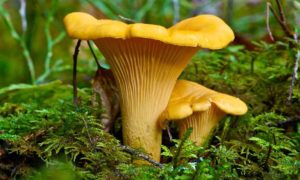
To make a broad generalization, Chanterelles are shaped like the bell of a trumpet, edible, and delicious. There are many different Chanterelle species, but the golden is what people usually mean when don’t specify. It is the chanterelle, probably because it is larger than many of the others, not to mention the beautiful yellow color. Unfortunately, now and then someone will pick and eat a Jack o’Lantern (Omphalotus illudens) instead of a chanterelle and get very sick. The two species don’t look alike to a practiced, careful eye, but not all eyes are practiced or careful—it’s all too easy to see a mushroom, notice that it’s yellow, and think “yum!”
Old-Man-of-the-Woods (Strobilomyces floccopus)
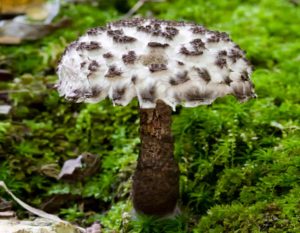
The old man is hard to mistake for anything else, and reportedly it tastes excellent fried up and then served in a bun like a burger. It is pale gray or whitish but covered with irregular tufts of short, dark hair. The overall “look” is dark and irregular.
Wood-Ear (Auricularia auricula)
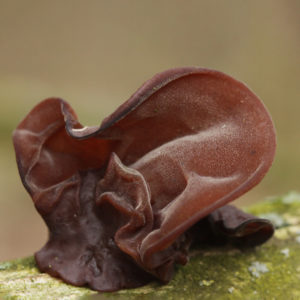
Yup, the wood-ear[i] usually looks like an ear stuck on a tree-branch. Some are less ear-like, depending on the exact shape. They are dark, reddish brown with a rubbery texture. They’re also edible—a similar, Asian species is often sold dried in specialty grocery stores and used to add texture to soups.
Pecan Truffle (Tuber lyonii)
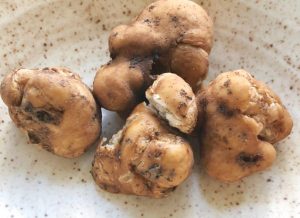
In general, a truffle is a bit like a puffball (though more firm) that grows underground. Many are not only edible but wonderfully aromatic—the scent works to attract hungry mammals who dig up the truffles and spread their spores. There are many different kinds. The pecan truffle[ii] got its name because it was first discovered in a Georgia pecan orchard, though the species is quite well-spread. It grows in partnership with certain trees, pecans but also others, gathering extra water and minerals and giving them to the roots in exchange for sugar. There are pecan truffle look-alikes, including some that are toxic, but it’s not difficult to learn the difference.
It’s possible to find pecan truffles, sometimes in very large quantities, by raking the soil, if one knows the right places to rake, but using a trained truffle-hunting dog instead has advantages—since dogs search by scent, they only find the truffles that are ready to harvest. The immature ones can say in the ground to be harvested later.
Macrocybe titans
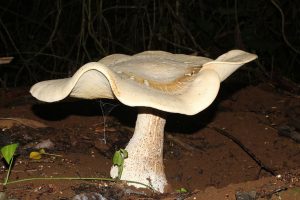
There doesn’t seem to be a common name for this species, though “really big mushroom” would be apt. Though some specimens are very small, many are large, and the biggest can get up to three feet across. They often grow in large clusters as well. And they’re edible, working in recipes very much the same way portabellos do. The smaller specimens can look like some toxic species, though, so caution is in order.
The really big mushroom[iii] appears to not have been in the United States until the early 20th century or even later. At most, it was present only in the southern tip of Florida. Its range has since been expanding, possibly in part because of climate change.
Psychedelic Magic Mushrooms in Georgia
Psilocybin and other psychedelic substances are illegal at the Federal level in the United States, but the states also have laws against them. Those in Georgia are among the most strict[iv]. Georgia is also unusual in banning possession of spores of psilocybin-containing species, even though the spores themselves do not contain psilocybin. A number of psychedelically-active species do grow wild in Georgia, but please be careful not to go to prison.
Don’t get dead, either; some of these species could be easily confused with the aptly-named Deadly Galerina, also present in the state.
Psilocybe weilii
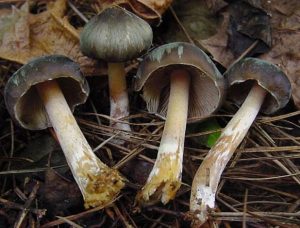
This species[v] was only discovered a few decades ago, and may in fact only grow in Georgia (and only part of Georgia at that). It grows happily in lawns—and very happily near leaking sewage pipes—but in wild areas it prefers clayey soils under loblolly pine and sweet gum trees. Users report it is one of the more potent Psilocybes, but given its extremely limited range, care must be taken not to over-harvest.
Psilocybe cubensis
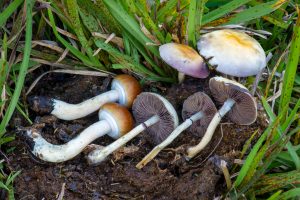
Perhaps the best-known magic mushroom, widely cultivated and available in many distinct strains. Its potency is moderate but may be variable. The original, wild form makes its home in many places across the world, including Georgia. The fungus eats the dung of large mammals and thus is common in horse and cow pastures.
Belted Mottlegill (Panaeolus subbalteatus)
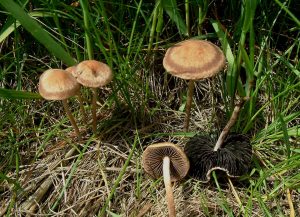
This species[vi] is wide-spread, in part because its spores have been accidentally transported in compost. It is also often cultivated. It’s unusual within its genus for often fruiting in groups. Its potency is considered low to moderate. It’s another dung-eater, and likewise often found in horse and cow pastures.
Fly Agaric (Amanita muscaria)
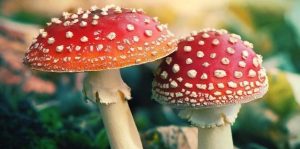
This species bears the common name “fly agaric,” because it supposedly kills or repels flies. Whether the fly trick works or not, most people don’t value this mushroom for fly control, and most don’t use the common name. They call it Amanita muscaria, the original magic mushroom.
A. muscaria is not as popular as the Psilocybes. It doesn’t contain psilocybin. Its “active ingredient” is different, less visual, more intellectual and physical—plus, the mushroom also contains a toxin that must be removed through careful processing if the user is not going to simply feel ill. But the species has its adherents, its admirers. It’s a pretty thing, too, with a red, orange, or yellow cap covered in white warts or spots.
Proper identification is critical. Several deadly-poisonous species are close relatives and show a family resemblance.
Poisonous Mushrooms in Georgia
Please remember that there is no reliable rule for knowing whether a mushroom is poisonous—if anyone tells you otherwise, they are wrong. People die by following rules that have poisonous exceptions. The only thing to do is learn to identify mushrooms to species. The following is by no means an exhaustive list!
Toxic Amanitas
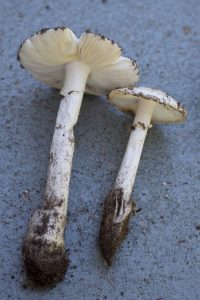
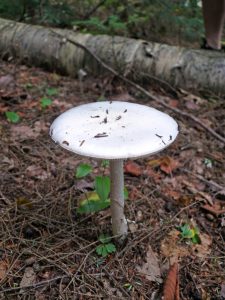
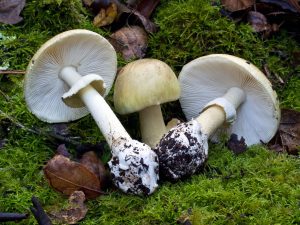
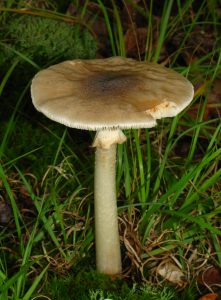
There are at least four species in Georgia that belong to the genus, Amanita, and can kill you[vii]: A. virosiformis, A. bisporigera, A. phalloides, and A. brunnescens. They have common names such as Death Angel, Destroying Angel, and Deathcap, though these names generally refer to more than one species, and in some cases multiple names refer to the same species. Most are white or whitish with a skirt of tissue around the upper stem and a cup of tissue at the base of the stem.
A. virosiformis[viii] is notable for its rot-like scent. A. bisporigera[ix] is widespread and nearly identical to several other species that mostly don’t grow in Georgia. A. phalloides[x] has a greenish cap. It’s a European species that has been spread across much of the world on the roots of trees sold by nurseries. A. brunnescens[xi] is known for the distinctive shape of the base of its stem, but unfortunately not all specimens have this distinctive shape. The color, generally whitish, varies as well. Not all Amanitas are poisonous, it’s just that the poisonous ones are so dangerous it’s usually better to leave the whole group alone. They are handsome-looking mushrooms, though.
The Sickener (Russula sp.)
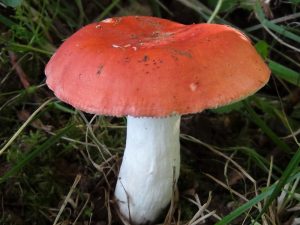
This pretty red and white mushroom is commonly and happily eaten by squirrels, but it causes severe gastrointestinal upset in humans. Poisonings are not generally fatal, but that’s no reason to risk them[xii].
Unfortunately, figuring out exactly which Russula you’ve got is nearly impossible because Russula taxonomy is a complete mess[xiii], with many species currently defined based on subtle differences between highly variable characteristics. Not all Russulas are red-capped, but the red- or reddish-capped ones usually get lumped into the “sickener” group and often treated as a single species, which they may or may not be.
False parasol (Chlorophyllum molybdites)
The false parasol is so-named because it looks like the several parasol mushrooms (except for having green spores) and, unlike them, make most people who eat them very, very ill. However, the situation is not quite a clean distinction between the true and edible parasols and the poisonous impostor; multiple members of the group sicken some people sometimes while being safely eaten by other people at other times, it’s just that this one makes eaters sick more often than not.
Deadly Galerina (Galerina marginata)
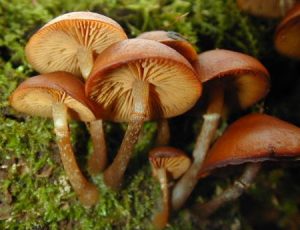
Another aptly-named mushroom! Except this one has the added feature of being a “little brown mushroom,” or LBM, meaning that it looks almost exactly like zillions of other little brown species, some of which are popular edibles or psychedelics. Best of all, it has a habit of growing near, or even mixed in with, groups of edibles or psychedelics, so that a forager might well properly identify a couple appetizing specimens in a group and then start harvesting without knowing the Deadly Galerina is there, too. When gathering LBMs for the table, pay attention to detail or die.
Incidentally, this is one of the few species that has been combined rather than split up in recent years; there used to be a whole flock of deadly galerinas, each with its own scientific name, but it turns out all of them are just G. marginata[xiv]. It grows pretty much everywhere.

My name is Austin Collins.
I've dedicated my life to Mushrooms.
I believe Mushrooms are the best kept secret when it comes to health and well being.
For that reason, I would like to share a company with you that in my opinion makes the best mushroom products on the market.
The company is called Noomadic Herbals, my favorite supplement they make is called "Mushroom Total".
I take their products every day and they have helped me think better and have more energy. Give them a try.
-Austin
References
[i] (n.d.). Wood Ear (Tree Ear). Missouri Department of Conservation
[ii] Grupe II, Arthur C., Brenneman, T., Bonito, G., Smith, M.E. (2019). The Pecan Truffle (Tuber lyionii): A Gourmet Truffle Native to the Southeastern US. IFAS Extension
[iii] Karlsen-Ayala, E., Smith, M.E. (2020). Macrocybe titans: The Mushroom Giant of the Western Hemisphere. IFAS Extension
[iv] (n.d.). Psychedelic Laws in Georgia. Psychedelic Invest
[v] de Boer, P. (2017). Psilocybe weilii. TruffleMagic
[vi] Jones, J. (n.d.). Panaeolus subbalteatus. Burke Herbarium Image Collection
[vii] Willis, D. (2008). Poisonous Plants and Mushrooms in the Landscape. Gwinnett County Master Gardeners Association
[viii] Kuo, M. (2020). Amanita virosiformis.
[ix] Kuo, M. (2013). Amanita bisorigera.
[x] Viess, D. (n.d.). Amanita phalloides: Invasion of the Death Cap. Bay Area Mycological Society
[xi] Kuo, M. (2013). Amanita brunnescens.
[xii] (n.d.). Russula emetica (Schaeff.)Pers.—The Sickener. First Nature
[xiii] Kuo, M. (2009). The Genus Russula.
[xiv] Kuo, M. (2016). Galerina marginata.


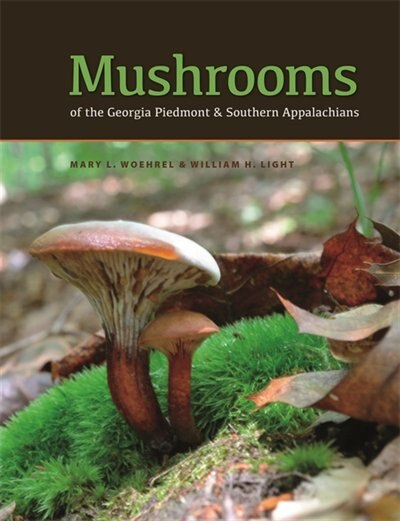
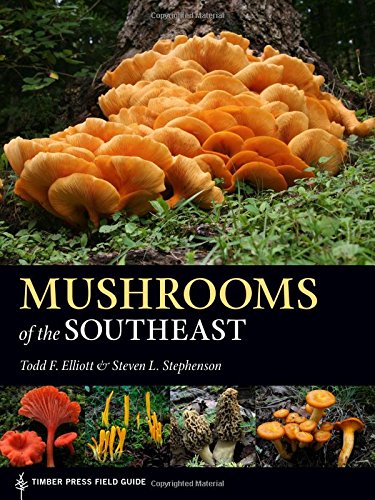

Hey Austin.
Just wondering if you do any sort of organized mushroom hunting and identifying in Georgia. I picked wild mushrooms as a kid with my Dad, and they were fantastic. But that was in Pennsylvania, and I don’t dare try to pick mushrooms here unless an expert can show me which ones are safe.
I’ve tried contacting some clubs, but never received any response and the local Oldtimers who might know these things are passing on. Thanks!
If you ever get any help in identifying wild edible mushrooms or medicinal mushrooms that are found growing in Georgia I’d also be very interested.
As a Parks and recreation employee I have come across many different mushrooms and I take photos of each one. I have never picked one but it’s quite interesting to see what my environment really consists of. I’ve lived here in Georgia for nearly 30 years and never knew about the mushrooms here
Mushrooms really are amazing, aren’t they?
I found alot of psychedelic orange mushrooms in the mountains of GA. I am going back and will take a picture of them because I can’t find the ID of them so far. Anyone have a good site for ID?
Rebecca
Hi Rebecca,
I suggest you use one of the recommended field guides in this article. Not only are they more in depth, but if you’re in the forest with no cell reception they are a great resource to have.
I live in northeast GA and have also found morels, king boletes, oysters, and meadow mushrooms. All which are delicious.
Every year after a wet, rainy. With thunder and lightning, we find the most wonderful batches of Chanterelle mushrooms around our home and in our woods! We sauté them and put them in a Alfredo sauce over fettuccine, noodles, and it is excellent! We sauté them in butter and garlic, and then pour fresh, whipping cream and freshly grated Parmesan cheese and the sauce is absolutely delicious.